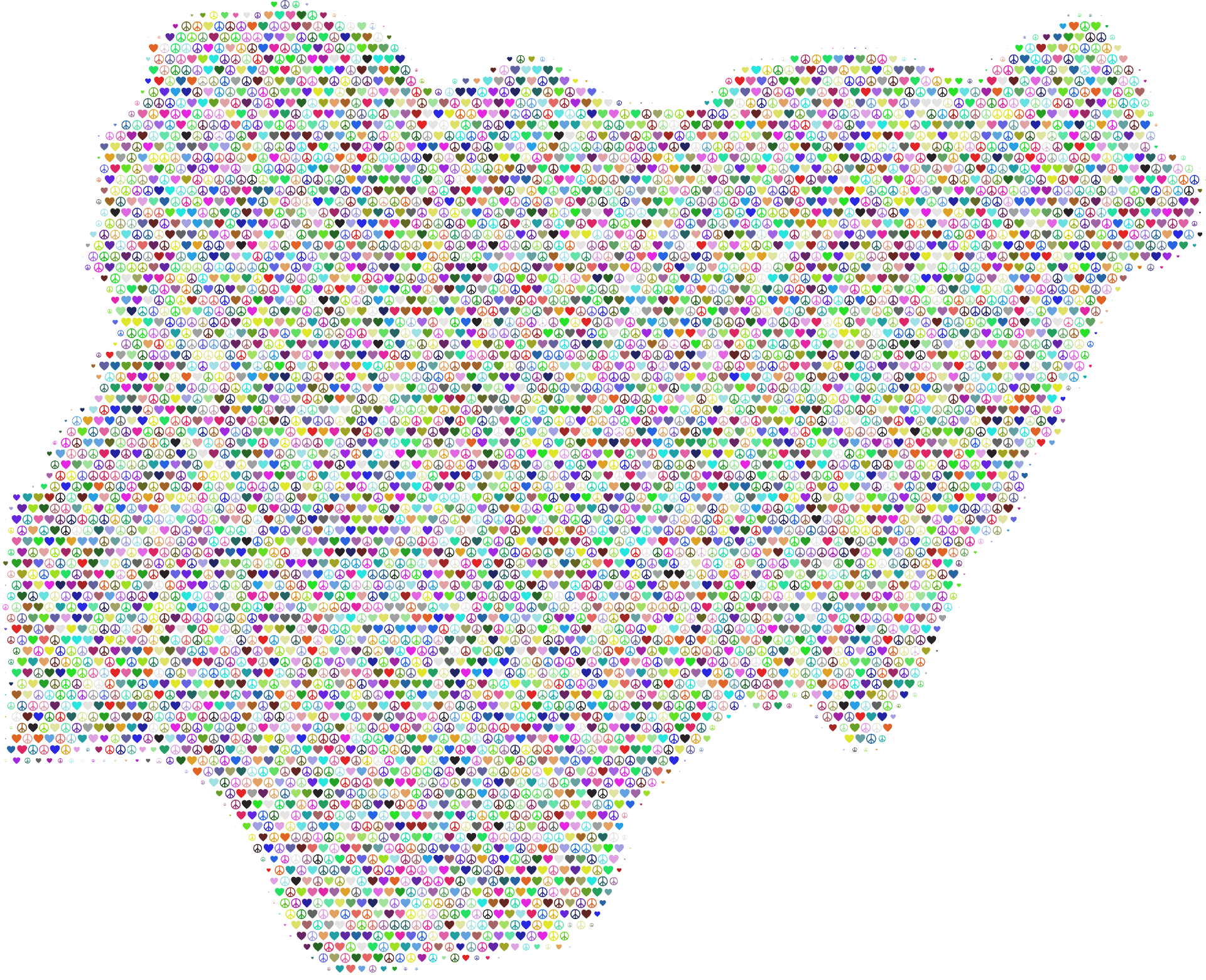Background
A language thrives when it is regularly used to communicate, while it dies when it is no longer used. While several factors are involved in a language’s preservation or potential extinction, we can examine a few vital points to validate its status.
Nigeria, a multicultural country, has an estimated 520 indigenous languages, according to Ethnologue. However, the English language is the country’s lingua franca, making it the most generally accepted language within the country.
Formal education is mainly delivered in English, and official communications are also done in English. For Nigerians from different indigenous tribes, the easiest way to communicate is in English, or at least in the local Creole, Nigerian Pidgin English.
The dominance of the English language in the public domain poses a significant threat to indigenous Nigerian languages. This is especially true for more minor languages within the nation, as they have both the lingua franca and the more dominant local languages to contend with.
There is much information to uncover about how well Nigeria’s Indigenous languages are still in use. However, limited information on indigenous Nigerian languages is available on the Internet.
The unavailability of information on the use of indigenous Nigerian languages and the level of language endangerment in Nigeria motivated us at Prepmewell Language Institute to gather real-time data by surveying Nigerians across various regions.
Overview
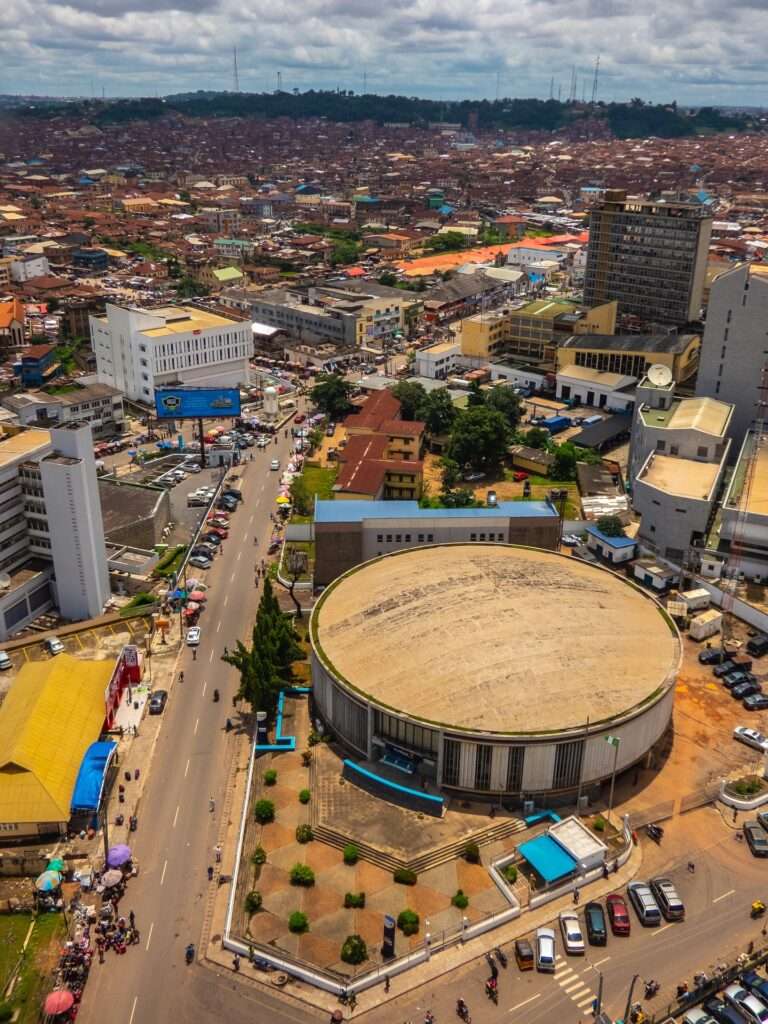
Using a digital form, we surveyed 838 Nigerians, including adults and schoolchildren, to evaluate their use of indigenous language. As we delivered this survey in English, the data we generated best represents the English-speaking populace.
For most indigenous Nigerian languages, it’s generally accepted that the most fluent speakers are the rural natives, who are largely uneducated. Considering these speakers are not accounted for in our data, we can assume that this report doesn’t represent the entire reality of Nigeria’s indigenous languages.
Regardless, based on Nigeria’s 62% literacy rate, according to Statista, the data from this report can be taken as representative of a more significant percentage of Nigerians.
Having established the genesis of our research, we can now analyse the data we gathered from this survey.
General analysis
Most of our survey respondents are young adults (44%) between 19 and 30 years old. We also gathered reasonable feedback from early middle-aged individuals and children. See the full distribution by age below:
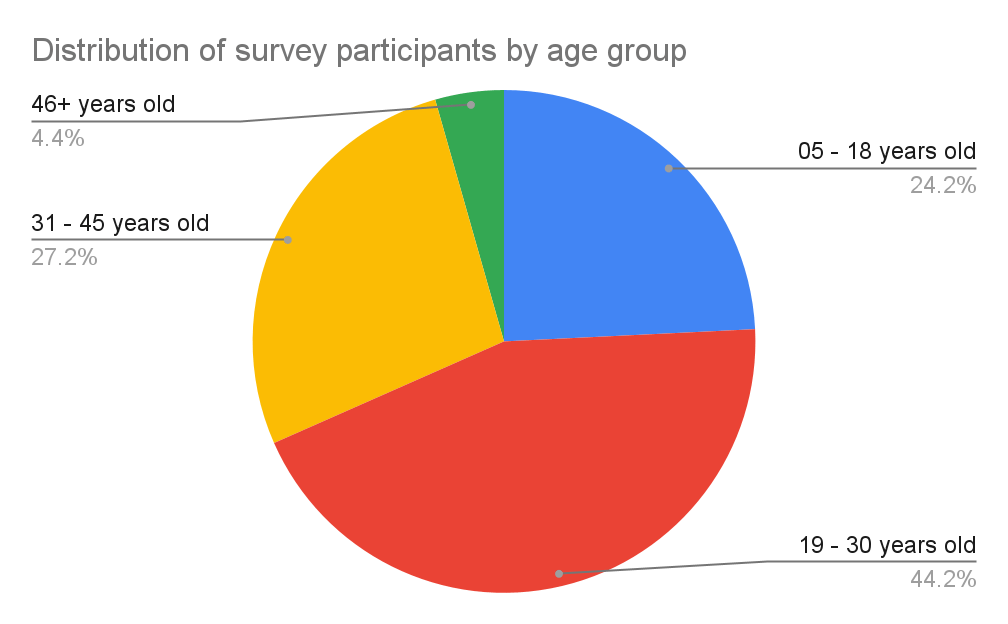
Our survey results featured 36 native languages. However, eight (8) indigenous language groups were best represented, making up 93% of survey responses. The Yoruba language was most represented, with 61% of responses, followed by the Igbo language with 21%.
See the full distribution by native languages below:
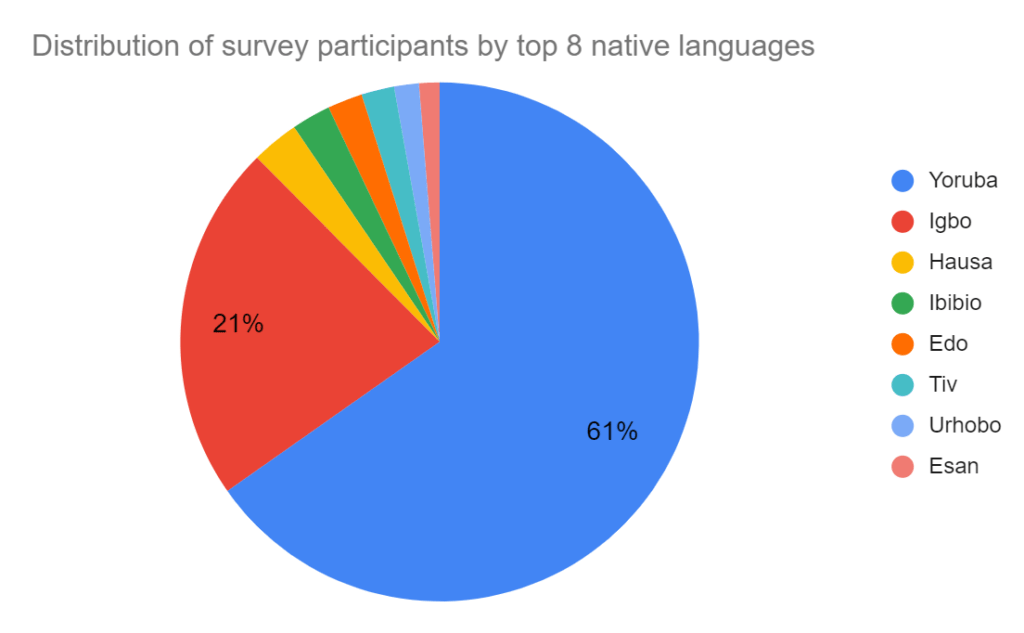
We also gathered information on the geographical location of respondents to see if there’s any correlation between location and the use of native languages. We have categorised our respondents’ locations into three:
- Region: people living within the region of their native tribe.
- Outside region: people living outside their nativity.
- Abroad: people living outside Nigeria.
See the distribution by location below:
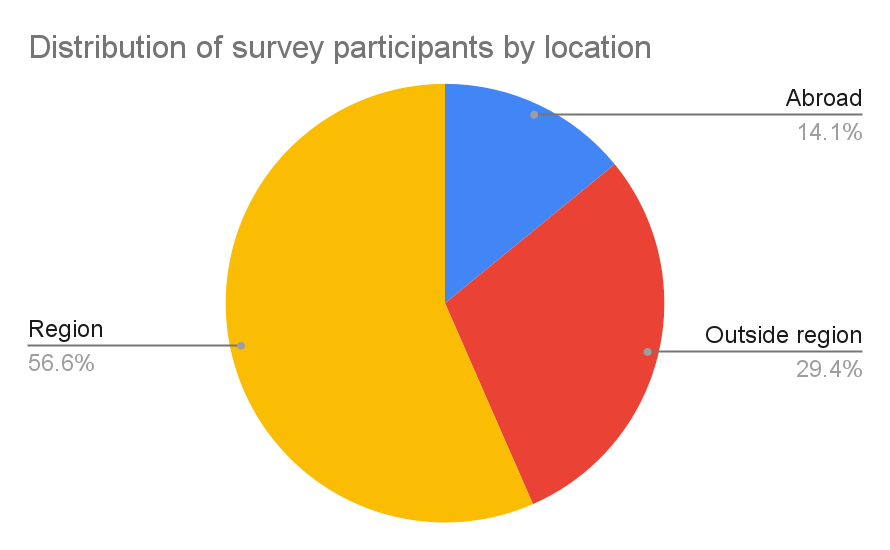
Use of Native Languages in Nigeria
To understand the use of native languages in Nigeria, we asked a series of questions about native language fluency. We then analysed the data using the four language skills: listening, speaking, reading, and writing.
Here’s an overview of native language fluency based on each of these language skills:
- Only 52% of Nigerians can understand their native language proficiently.
- Only 48% of survey participants can speak their native language fluently.
- Only 28% can read fluently in their native language.
- Only 27% can write proficiently in their native language.
See the distribution below:
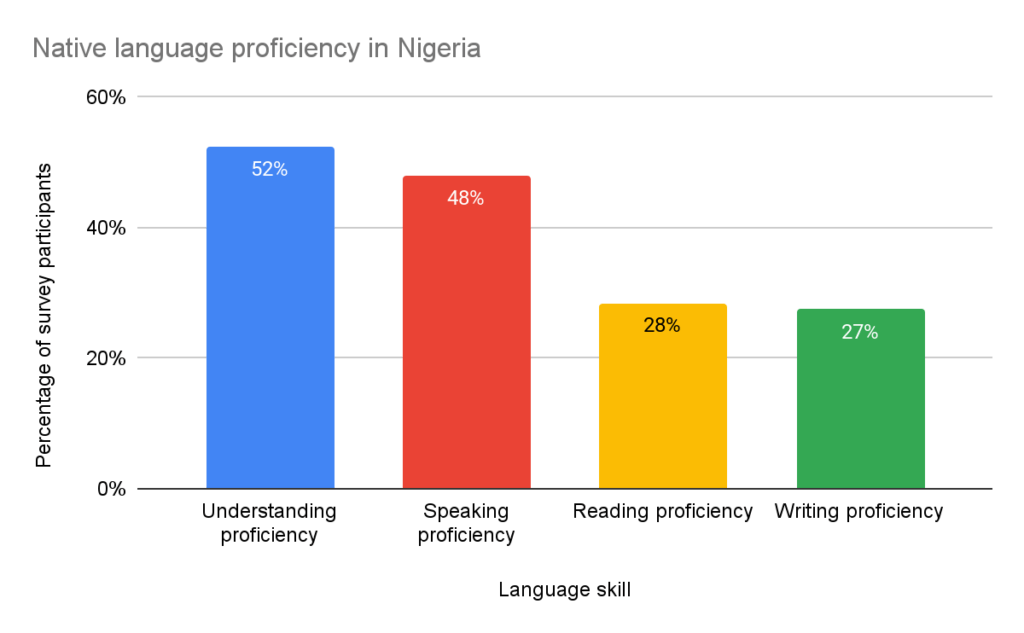
Likewise, our survey found that 38% of Nigerians rarely use their native languages in daily conversations.
These numbers indicate that indigenous languages are not predominant among educated Nigerians. Again, we attribute this to the preference for generally accepted languages like English and Nigerian Pidgin.
Particularly concerning is that reading and writing in indigenous languages is quite challenging among the literate populace. As reading and writing play a crucial role in language preservation, Nigeria’s indigenous languages could suffer a critical hit if its literate populace can’t interact with texts in their native languages.
The data we’ve presented up until now represents our survey group as a whole. Now, we can analyse indigenous language use in Nigeria based on specific categories like age and location.
Analysing Indigenous Nigerian languages based on age groups
Why categorise based on age? According to Languages in Danger, two of the factors that indicate that a language is endangered have to do with age:
- When the mean age of native and fluent speakers is high.
- When the percentage of the youngest generation acquiring fluency in the language is low,
If we can learn the average age of fluent speakers of our indigenous languages, we can tell if our languages are endangered or not.
To do this, we analysed the language skills of our survey participants based on their age groups. The data is represented below:
Listening and speaking
- 89% of Nigerians above 46 years can understand their language fluently. In contrast, only 30% of the youngest generation (ages 5-18) have acquired fluency in their mother tongue.
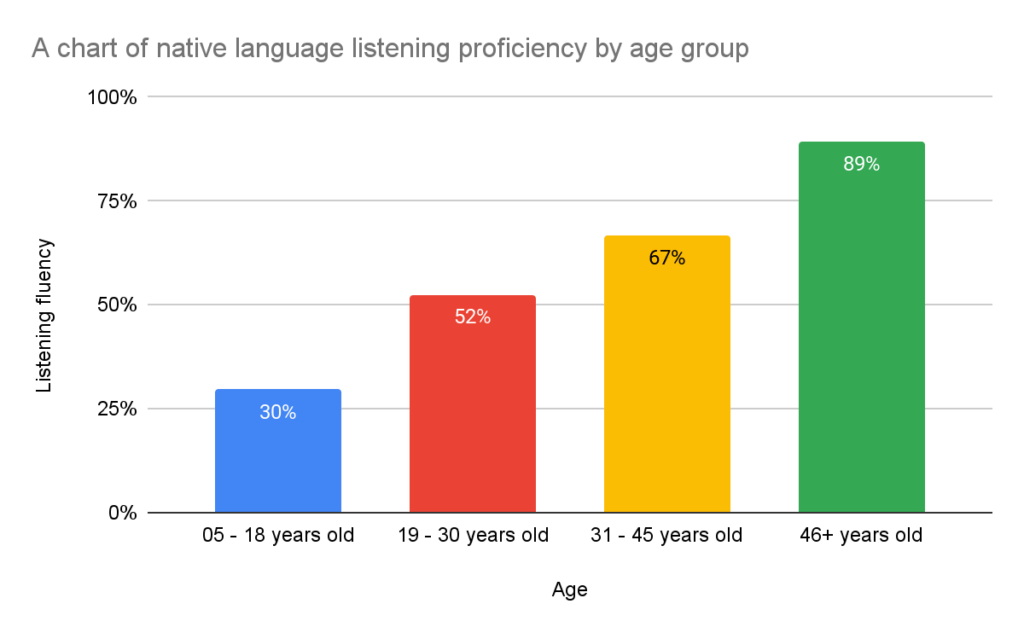
- Again, 89% of Nigerians above age 46 can speak their native language fluently. Yet, only 27% of Nigerians aged 5-18 can speak their indigenous language fluently.
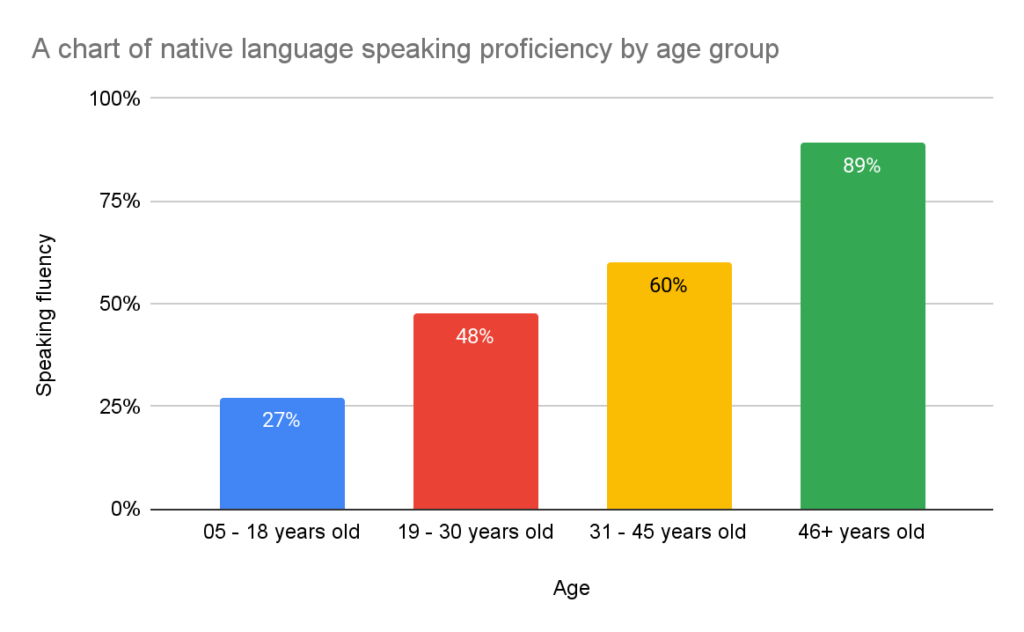
So far, the data agrees with the two indicating factors pointing towards language endangerment.
Reading and writing
Let’s look at how these age groups compare in their use of reading and writing skills.
- About 59% of our survey participants above age 46 can read fluently in their native language, while 19% of the children we surveyed can read their native language proficiently.
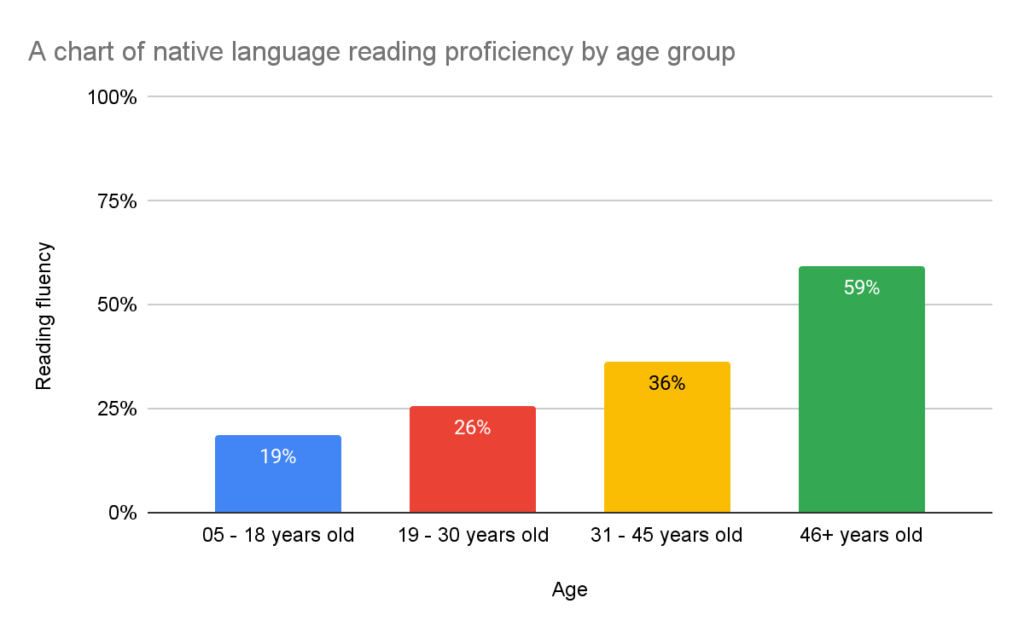
- In like manner, 62% of Nigerians above age 46 can write proficiently in their indigenous language, but only 15% of the youngest generation (ages 5-18) can do the same.
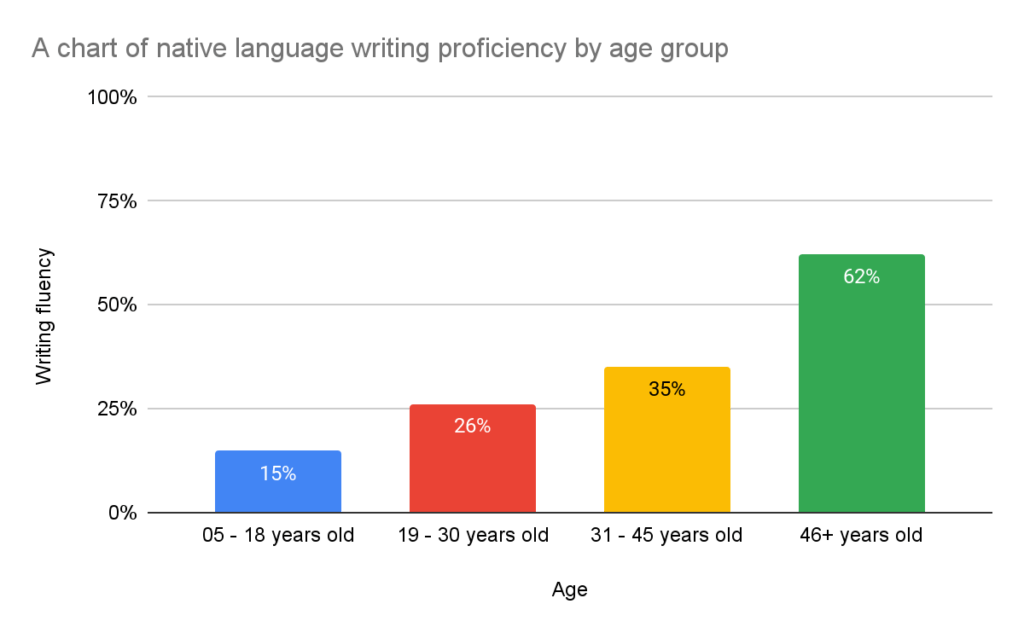
We see here that reading and writing in indigenous Nigerian languages is challenging for all age groups. However, the youngest generation is most critically affected. This is another pointer to language endangerment in Nigeria.
Use in daily conversations
As we’ve established earlier in this piece, the more actively a language is used by its native speakers, the lower its chances of extinction. In this survey, we examined how rarely Nigerians use their indigenous language in daily conversations.
Only 8% of respondents above age 46 rarely used their native language daily. Conversely, half of Nigerian children surveyed seldom used their native language in everyday interactions. See the distribution below:
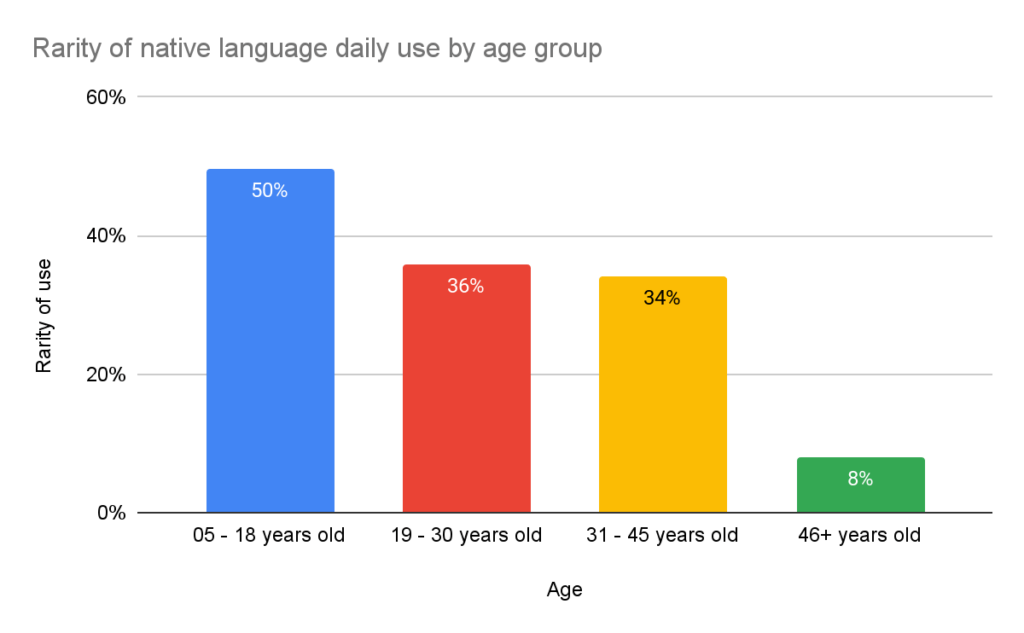
The more prevalent use of indigenous languages among older generations and much less by the youngest generation is a testament to the younger generation not being raised with their indigenous language as their primary language.
Rather, in many urban Nigerian homes, English is the primary language of communication with the children.
This highlights one of the fundamental problems that must be solved in Nigerian homes. Parents need to be well versed in their indigenous language so they can instil this language as the mother tongue for their children. This starts with the current generation of young adults gaining fluency in their native language.
There’s also the issue of preferring the globally relevant English language to the local indigenous language. However, we must know that language is not a “one or the other” decision. Children can be raised as bilinguals without any disadvantages in language skills compared to monolinguals.
Analysing Indigenous Nigerian languages based on speaker’s location
Location contributes significantly to language use and lack of use. The predominant language in a place is the primary tool for communication and daily activities in that region.
Based on the categorisation of our survey respondents’ locations, we can examine Nigerians’ proficiency in their indigenous languages.
Listening and speaking
- 67% of survey participants abroad understand their indigenous language proficiently. While only 44% of those living outside their native region understand their language well.
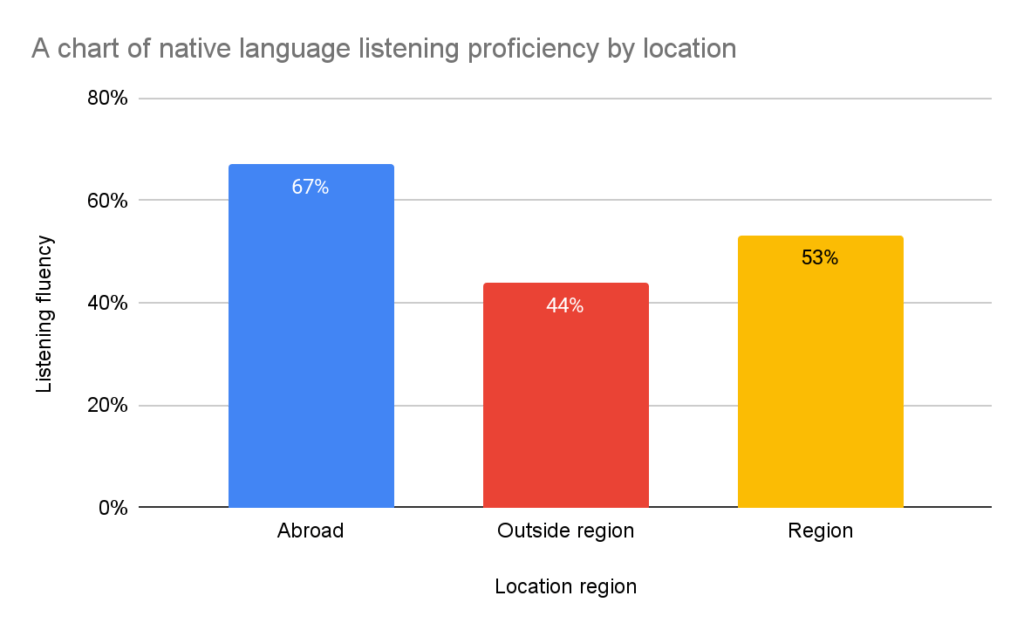
- Again, 61% of Nigerians living abroad can fluently speak their native language, which is even higher than the 51% of those living within their region in Nigeria.
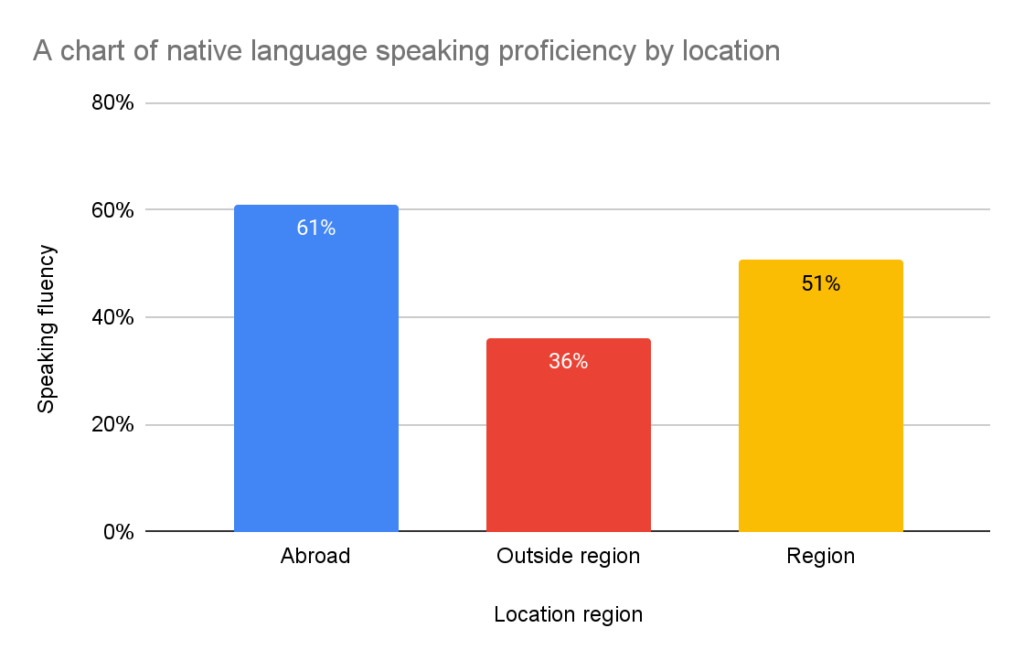
Surprisingly, a higher percentage of Nigerians living abroad can understand and speak their indigenous language, even more than Nigerians living within their native region.
The only explanation is that most Nigerians who travel abroad are well-educated in English and their mother tongue. However, they face a peculiar challenge of passing this mastery of their indigenous language to their children.
We asked Nigerians abroad to rate their child’s use of indigenous language. And 93% say their child can’t understand or speak their native language, or at best, they would struggle to do so.
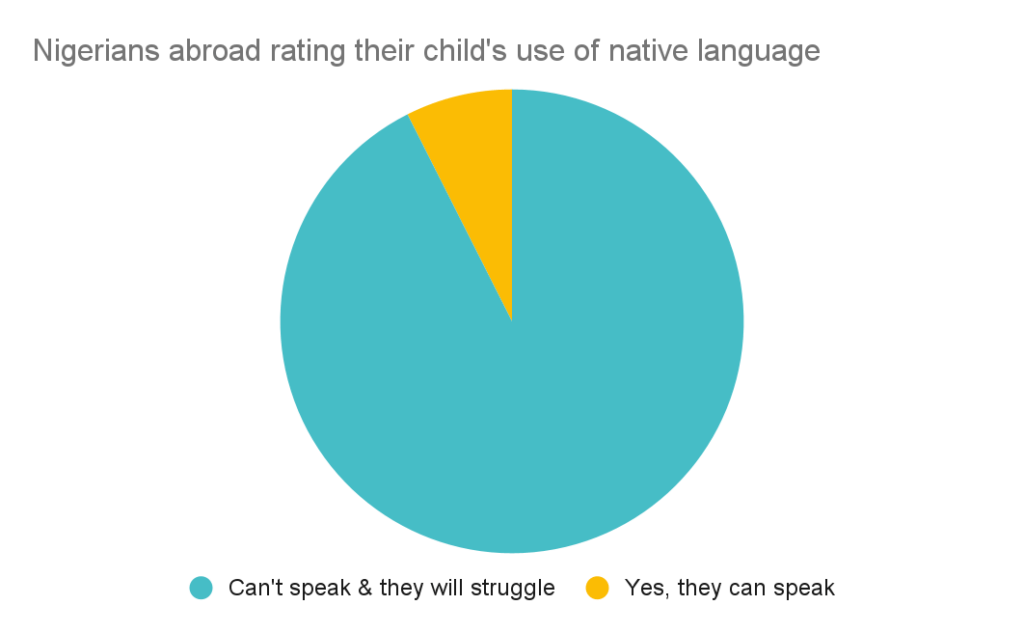
This again drives home the point that location plays a crucial role in the continuity of a language. Living in a country where one’s indigenous language is not spoken at all makes it much more challenging for the youngest generation to learn the language at all, much less become proficient at it.
In our previous article, we explained more on the challenges of learning a Nigerian language and how long it takes to do so. Click the link to read it.
Reading and writing
- 37% of survey participants living abroad can read texts in their indigenous Nigerian language smoothly. While only 21% of Nigerians living outside their native region in Nigeria can do the same.
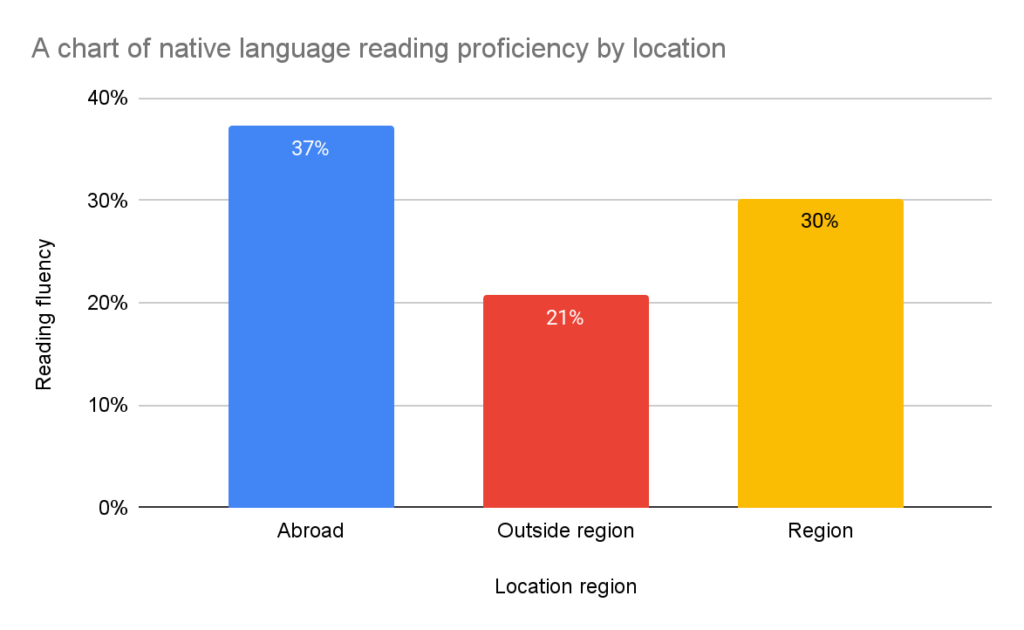
- For writing proficiency, the figures follow the same trend.
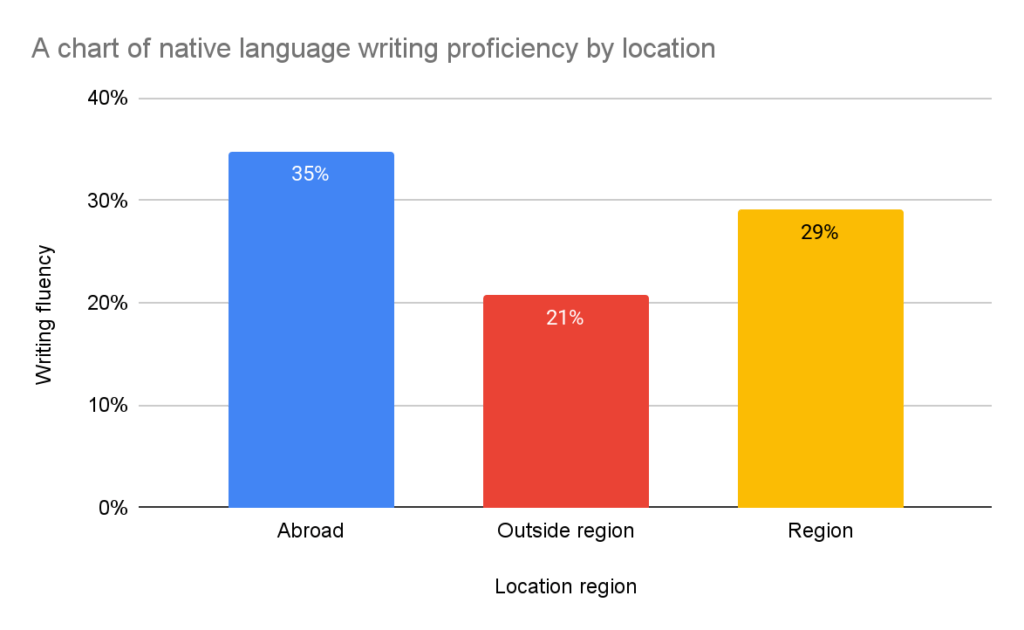
Use in daily conversations
- Regarding daily use, Nigerians living outside their native region speak their native language the least, with 52% rarely speaking their native language.
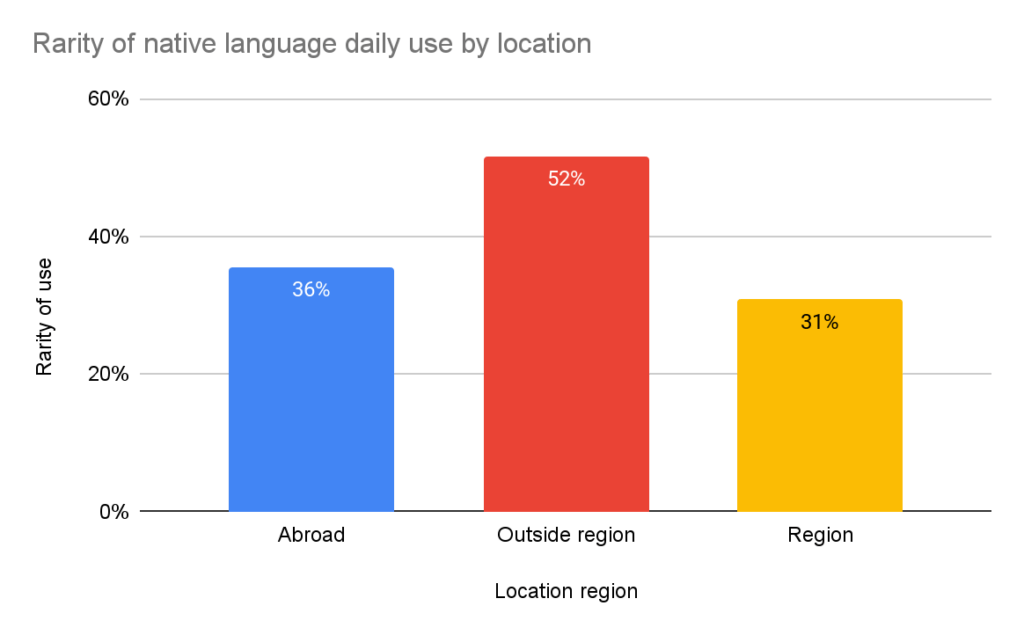
Up to 31% of Nigerians living in their region rarely speak their native language daily, which is also alarming. This means one out of three Nigerians doesn’t speak their native language enough, even though they live around other native speakers of their language. This points to a need to embrace our indigenous languages more as a primary means of communication.
Deductions from this report
Overall, the results from this survey suggest that Nigerians must improve their use of indigenous languages. From the focus areas in this article, there are three key areas where Nigerians can make some adjustments:
- The older, more proficient generation of Nigerians must ensure they teach their indigenous language to the younger generations.
- Indigenes living in the diaspora or outside their native region must make extra effort to learn their native language.
- Natives should readily communicate daily with other speakers of their indigenous language.
To facilitate these improvements across board, here are our recommendations:
- Nigerians who are fluent in their indigenous language should be more willing to teach others their native tongue.
- Less proficient speakers can enrol in indigenous language classes.
- Learning and embracing the indigenous culture and history can help boost the love for the language.
- Speak your indigenous language as often as possible. This can happen by belonging to a language community where indigenous language speakers and learners can interact frequently.
